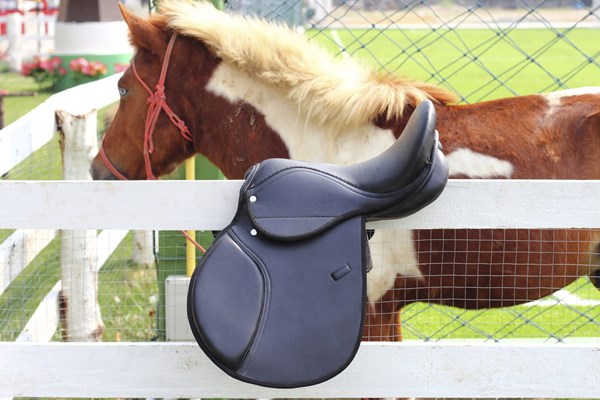 Credit: Thinkstock
Credit: ThinkstockYour bridle, reins and saddle can get stiff if you ride in rain without cleaning and conditioning them afterward.
“Many people think that rawhide reins are indestructible, but they also need lubrication within the fibers,” said Jeff Minor, a saddle maker at Baker, Idaho. “It takes longer to work it in, because of the structure of the rawhide, but they still need just as much care. They may be even more susceptible to the harmful effects of rain and moisture because they soak it up more quickly. Leather remains fairly soft even after water opens the pores, whereas rawhide gets softer (because it soaks up more) and then when it dries it dries hard and stiff.
Links in articles are part of an Amazon Affiliate program that provides income to support this brand. Links are chosen by our editors.
“Never use heat when drying leather (whether it got wet in the rain, or wet from being cleaned) or it will dry stiff,” advised Minor. “It’s always better to air dry it.”
He tells people to take the bridle reins off when they get back to the house after riding in the rain and hang them up somewhere, but not behind the stove.
“Many old saddles that have been stored for years and not cleaned/lubricated turn black and become hard, stiff and cracked,” said Minor. “When you try to bend that leather, it will break. Once a piece of old, neglected leather gets to a certain point, there’s not much you can do to bring it back; it gets past a point of no return. But if you keep it in a lubricated state, it will last a very long time. It could last indefinitely if it’s kept supple enough to accept all the lubricating agents that you put into it.”
Dry leather needs oiling, according to Cary Schwarz, a saddle maker at Salmon, Idaho. “You’ll be able to tell how much oil to use, because the dry leather will drink it in,” he said. “At room temperature, indoors, or in warm sun, where the leather is warm, it will receive oil quite readily.It’s also best if the oil is warm. On the label it may recommend that you heat it to about 100 to 110 degrees. It should feel warm to the touch. I have a hot plate where I warm my oil. Even with new leather, I like to have the oil warm. I may not always get it quite up to 100 to 110 degrees, but if it’s warm it will dissipate into the leather fibers more readily.
“You can heat the oil on a stove, in a saucepan with water,” continued Schwarz. “It’s probably safer to put the oil container in the hot water rather than directly on the burner, or it may get too hot. That way you can control the temperature.If you can touch and handle the oil, it’s not too hot.”
It can be hotter than 110 and won’t hurt new leather, but it might get too hot to handle—and would definitely be too hot for treating old leather.
“Leather absorbs warm oil very readily,” said Schwarz. “After you oil it, let it sit awhile, and in a few hours or another day, come back and feel the leather. If it feels brittle and dry, it needs more.If it feels like there’s some life back in it, that’s enough. Over-oiling can be just as bad as under-oiling. Too much oil can break down the fibers. You need to strike a balance, so the leather is pliable.If there’s any stiffness or brittleness, it needs more oil or some kind of conditioner. Then, after the leather is pliable again, you can go apply R.M. Williams Saddle Dressing or saddle butter, to seal it and protect it.
“If you use a wax-based product, it is critical that you do it under warm conditions,” he stated. “You don’t have to warm the product, but it’s important that the leather be warm to absorb it. The product has beeswax and other hard waxes in it, and if it’s cold, it will just cake on. It will take a lot more elbow grease to get it to render into the pores of cold leather than it would if it were warm.”
Schwarz said to render it and help break down the wax, “I sometimes use a hand-held blow drier. Warmth helps the wax go into the leather faster. On a carved saddle, especially, it will cake into the creases. But the drier will warm it enough that it will soak right in. If you can get some penetration with the wax-based product, then when the leather cools, the wax hardens. That’s where you get the sealing effect that works so well as a moisture barrier. You don’t have to get the leather hot, just warm enough to help melt the wax.
“After that I use a piece of soft cloth and buff any excess off, so it doesn’t have a sticky finish and won’t collect airborne dust,” said Schwarz. “You want a nice, slick, smooth finish. It repels moisture and dust better that way, and will help protect the leather from mildew. The mold spores won’t penetrate the leather.”


